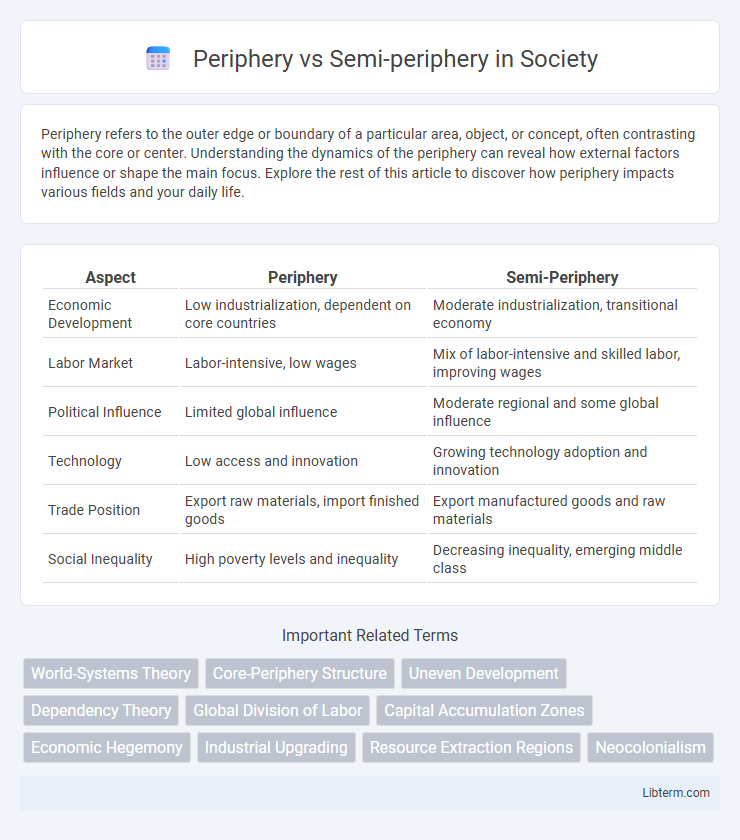Periphery refers to the outer edge or boundary of a particular area, object, or concept, often contrasting with the core or center. Understanding the dynamics of the periphery can reveal how external factors influence or shape the main focus. Explore the rest of this article to discover how periphery impacts various fields and your daily life.
Table of Comparison
| Aspect | Periphery | Semi-Periphery |
|---|---|---|
| Economic Development | Low industrialization, dependent on core countries | Moderate industrialization, transitional economy |
| Labor Market | Labor-intensive, low wages | Mix of labor-intensive and skilled labor, improving wages |
| Political Influence | Limited global influence | Moderate regional and some global influence |
| Technology | Low access and innovation | Growing technology adoption and innovation |
| Trade Position | Export raw materials, import finished goods | Export manufactured goods and raw materials |
| Social Inequality | High poverty levels and inequality | Decreasing inequality, emerging middle class |
Understanding World Systems Theory
Periphery countries are often characterized by low levels of industrialization, dependency on core countries for capital and technology, and a focus on exporting raw materials, whereas semi-periphery nations exhibit traits of both core and periphery, acting as intermediaries in the global economic system. World Systems Theory emphasizes the interconnectedness of these zones within a capitalist world economy, where semi-periphery regions both exploit periphery countries and are exploited by core countries. This dynamic reinforces global inequalities while enabling economic mobility and reconfiguration within the global hierarchy.
Defining Periphery and Semi-Periphery
Periphery nations are characterized by underdeveloped economies, low levels of industrialization, and dependency on core countries for capital and technology. Semi-periphery countries act as a transitional zone with moderate industrialization and economic diversification, serving as both exporters and importers in the global market. This classification highlights the stratified global economic system where semi-periphery buffers the wealth disparity between dominant core and exploited periphery regions.
Historical Origins of Global Inequality
Periphery countries, often characterized by limited industrialization and reliance on extractive economies, historically emerged through colonial exploitation and unequal trade systems imposed by core nations. Semi-periphery regions display transitional economic structures, combining both industrial sectors and peripheral traits, shaped by shifting global power dynamics during the rise and decline of empires. This historical layering of economic dependence and structural imbalances underpins the persistent global inequality observed in contemporary world-systems theory.
Key Characteristics of Periphery States
Periphery states are characterized by low levels of industrialization, weak economic infrastructure, and dependence on core countries for capital and technology. These nations often have limited political power and face challenges such as poverty, underdevelopment, and exploitation of natural resources. Their economies tend to focus on raw material extraction and agricultural production, with minimal diversification or integration into global markets.
Essential Features of Semi-Periphery Nations
Semi-periphery nations exhibit characteristics of both core and periphery countries, acting as a buffer zone in the world system. They possess moderate levels of industrialization, diversified economies, and intermediate political stability, contributing to a mixed role in global trade and economic networks. These nations often experience uneven development, balancing between exploitation by core countries and exerting influence over peripheral regions.
Economic Roles in the Global Hierarchy
Periphery countries typically exhibit low levels of industrialization and are heavily dependent on exporting raw materials and cheap labor to core nations, reinforcing economic inequality in the global hierarchy. Semi-periphery nations act as intermediaries by engaging in both manufacturing and resource extraction, often serving as emerging industrial hubs with moderate economic diversification. This transitional role allows semi-periphery countries to partially influence global trade networks while still relying on weaker economic sectors characteristic of peripheral regions.
Political Power and Influence
Periphery countries hold limited political power on the global stage, often dependent on semi-periphery and core nations for economic and political support. Semi-periphery nations possess moderate political influence, acting as intermediaries that can negotiate and exert regional control while balancing pressures from core powers. This intermediary status allows semi-periphery countries to shape geopolitical dynamics and influence international policies in ways periphery nations typically cannot.
Social and Cultural Dynamics
Periphery regions often exhibit social and cultural dynamics shaped by economic dependency and limited access to global networks, resulting in marginalized identities and traditional social structures. Semi-periphery areas display hybrid cultural traits, blending indigenous practices with influences from core economies, fostering social stratification and emerging middle classes. These complexities influence patterns of migration, identity formation, and cultural resilience within global socio-economic hierarchies.
Case Studies: Periphery vs Semi-Periphery Examples
Periphery regions such as Sub-Saharan Africa often exhibit low industrialization, reliance on primary commodity exports, and limited infrastructure, which contrasts sharply with semi-periphery examples like Brazil and India that display emerging industrial sectors and increasing integration into the global economy. Brazil's semi-peripheral status is marked by diversified manufacturing, expanding technology sectors, and growing influence in international markets, while many periphery countries remain dependent on foreign capital and vulnerable to economic volatility. Case studies reveal that semi-periphery nations serve as economic and political intermediaries, bridging the gap between dominant core countries and marginalized periphery states.
Future Trends and Shifting Global Positions
Emerging economies in the semi-periphery are anticipated to gain greater influence as technological innovation and industrial diversification reduce dependence on core economies. Investment in education and infrastructure within semi-peripheral countries fosters competitive advantages, enabling them to challenge the traditional dominance of core nations. This shift could lead to a more multipolar global economy, with nuanced roles for both peripheral and semi-peripheral regions in international trade and diplomacy.
Periphery Infographic

 libterm.com
libterm.com